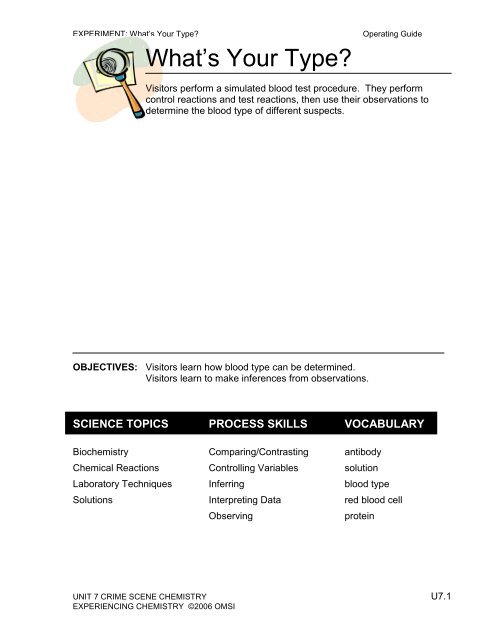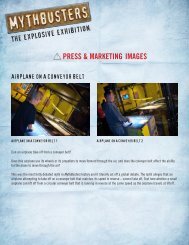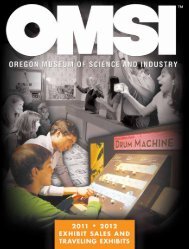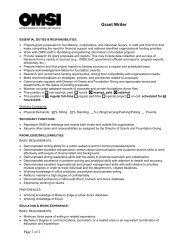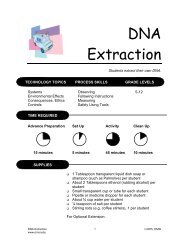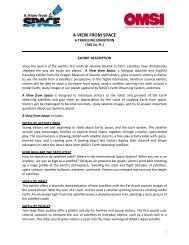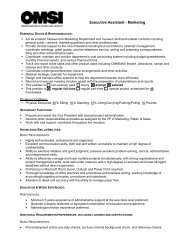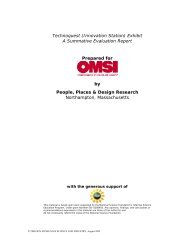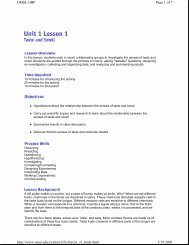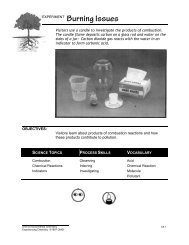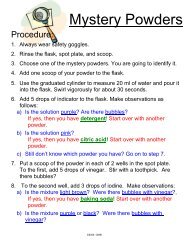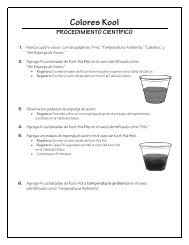Experiment: Latent Fingerprinting - OMSI
Experiment: Latent Fingerprinting - OMSI
Experiment: Latent Fingerprinting - OMSI
You also want an ePaper? Increase the reach of your titles
YUMPU automatically turns print PDFs into web optimized ePapers that Google loves.
EXPERIMENT: What’s Your Type?What’s Your Type?Operating GuideVisitors perform a simulated blood test procedure. They performcontrol reactions and test reactions, then use their observations todetermine the blood type of different suspects.OBJECTIVES: Visitors learn how blood type can be determined.Visitors learn to make inferences from observations.SCIENCE TOPICSPROCESS SKILLSVOCABULARYBiochemistryChemical ReactionsLaboratory TechniquesSolutionsComparing/ContrastingControlling VariablesInferringInterpreting DataObservingantibodysolutionblood typered blood cellproteinUNIT 7 CRIME SCENE CHEMISTRY U7.1EXPERIENCING CHEMISTRY ©2006 <strong>OMSI</strong>
EXPERIMENT: What’s Your Type?Operating GuideWhat’s Your Type?Procedure1. Always wear safety goggles.2. Rinse the well plate in the sink.3. Add 8 drops of water to each well in the water row.4. Add 8 drops of Antibody Type A solution to each well inthe antibody row.5. You will now perform the control reactions*Add 8 drops of Type O blood to each well in column O*Add 8 drops of Type A blood to each well in column AWhat happens when Type O blood mixes with Aantibodies?What happens when Type A blood mixes with Aantibodies?6. You will now perform the test reactions*Add 8 drops of Suspect X blood to each well in column X*Add 8 drops of Suspect Y blood to each well in column Y*Add 8 drops of Suspect Z blood to each well in column Z7. Closely observe the reactions in all the wells.Which suspect(s) have type A blood? How do youknow?8. Rinse the well plate in the sink.U7.2 UNIT 7 CRIME SCENE CHEMISTRYEXPERIENCING CHEMISTRY ©2006 <strong>OMSI</strong>
EXPERIMENT: What’s Your Type?Operating GuideHow is blood typedetermined?A Closer Look:In this experiment, you mixed chemical solutions tosimulate a blood typing reaction. In blood typing,scientists use antibodies that bind to the proteins on thesurface of red blood cells. Blood cells of different bloodtypes have different proteins on their surfaces.When Type A antibodies mix with Type A blood, theantibodies bind to the Type A proteins and cause theblood cells to clot. Since Type O blood does not haveType A proteins, there is no clotting reaction.People can have Type O, Type A, Type B, or Type ABblood. By using blood type tests, forensic scientists andpolice officers can identify people who may have left bloodat a crime scene.For our simulation, the “Type A blood” solution containsred food coloring and iron. When the “Type A blood”reacts with the “Antibody Type A” solution, a new solidcompound forms. This solid mimics the blood clot formedin forensic blood tests.UNIT 7 CRIME SCENE CHEMISTRY U7.3EXPERIENCING CHEMISTRY ©2006 <strong>OMSI</strong>
EXPERIMENT: What’s Your Type?Operating GuideMATERIALS(with amounts to have on hand)KOH (potassium hydroxide) (keep 20g on hand)FeCl 3 •5H 2 0 (ferric chloride hexahydrate) (keep 30g on hand)waterred food coloryellow food colorwell platetwo 75mL squeeze bottlesfive 125mL squeeze bottlestwo one-liter bottlesone 500 mL bottleSetup/Takedown ProceduresORIGINAL SETUPLabel the wellplate with white label “wellplate.” Attach labels toindicate the water row (blue), antibody row (yellow), Type Acolumn (white), Type O column (white), Suspect X column(green), Suspect Y column (green), Suspect Z column (green).Label one 75mL squeeze bottle “water” in blue.Label one 125mL squeeze bottle “antibody Type A” in yellow.Label two large squeeze bottles in white “Type A blood” and“Type O blood.”Label three large squeeze bottles in green “Suspect X blood,”“Suspect Y blood,” and “Suspect Z blood.”WEEKLY SETUPTest reactions since stored solutions may degrade. Remakesolutions as necessary (see Materials Prep).Check that colors of blood solutions are approximately the sametint. Adjust color by addition of red and/or yellow food coloringPrepare FeCl 3 (ferric chloride) solution, water solution, and KOH(potassium hydroxide) solution if needed (see Materials Prep).U7.4 UNIT 7 CRIME SCENE CHEMISTRYEXPERIENCING CHEMISTRY ©2006 <strong>OMSI</strong>
EXPERIMENT: What’s Your Type?Operating GuideDAILY SETUPSet out the visitor instructions in a Plexiglas holder.Refill all squeeze bottles with appropriate solutions.On a tray lined with a white mat, set out the following:- Labeled squeeze bottles of Type A blood, Type O blood,Suspect X blood, Suspect Y blood, and Suspect Z blood.- Labeled squeeze bottles of water and Antibody Type A- wellplateGroup the color-coded supplies together on the tray.DAILY TAKEDOWNRinse the wellplate. Use a paper towel to wipe out any rust inall wells.Rinse and wipe the tray, clean off all rust spots. Stubborn rustspots may be removed with vinegar.Cap all bottles and store upright in tub under counter.WEEKLY TAKEDOWNSponge out the tub.Rinse the wellplate. Use a paper towel to wipe out any rust inall wells. Stubborn rust spots may be removed with vinegar.Cap all bottles and store upright in tub.Rinse and wipe the tray, clean off all rust spots. Clean the trayand leave it at the station.RUNNING SUGGESTIONSWipe up any rust stains as they appear. Wipe out well plate asneeded. Simple friction should be enough to remove rust.Suggest to visitors to hold the well plate up to the light to betterdetect reaction of Type A blood and antibody Type A solution.UNIT 7 CRIME SCENE CHEMISTRY U7.5EXPERIENCING CHEMISTRY ©2006 <strong>OMSI</strong>
EXPERIMENT: What’s Your Type?Operating GuideEXTENSIONSDiscuss the importance of blood typing in medical practice.Using an inappropriate blood type in transfusions leads tocomplications since a patient’s body will reject an incorrectblood type.Blood type is hereditary and distribution varies in differentpopulations. For instance, among Americans Type O blood ismost common, and Type AB blood is very rare. AmongJapanese the four types Type O, Type A, Type B, and Type ABare almost evenly distributed.This simulation uses a replacement reaction to create aprecipitate. The actual reaction is:Fe 3+ (aq) + 3OH - (aq) Fe(OH) 3 (ppt)FeCl 3 and KOH are both soluble in water. But when ironreplaces potassium, an insoluble compound is formed.Safety & DisposalHealth: 3Flammability: 0Reactivity: 2Contact: 4Health: 3Flammability: 0Reactivity: 2Contact: 4Caution: Solid potassium hydroxide causes severe burns and maybe fatal if swallowed. Wear goggles and gloves while using, andwash hands after use. See MSDS for further information.Caution: Solid ferric chloride hexahydrate is a skin irritant. Weargoggles and gloves while using, and wash hands after use. SeeMSDS for further information.Unused solutions may be poured down sink drain. Follow standardlab procedures.U7.6 UNIT 7 CRIME SCENE CHEMISTRYEXPERIENCING CHEMISTRY ©2006 <strong>OMSI</strong>
EXPERIMENT: What’s Your Type?Operating GuideMATERIALS PREPTo prepare 0.6 M KOH (potassium hydroxide) solution:**This solution is used for antibody Type A solution**Caution: Solid potassium hydroxide causes severe burns andmay be fatal if swallowed. Wear goggles and gloves whileusing, and wash hands after use. See MSDS for furtherinformation.1. Measure 300 mL water in a 1-liter beaker.2. Weigh 16.83g KOH. Add it to the beaker. Stir to dissolve.3. Add water to final volume of 500 mL.4. Store in 500 mL bottle. Label should read “Antibody Type A, 0.6M KOH.”To prepare 0.1 M FeCl3 (ferric chloride) solution:**This solution is used for Type A blood, Suspect Y blood, and Suspect Z blood**Caution: Solid ferric chloride hexahydrate is a skin irritant.Wear goggles and gloves while using, and wash hands afteruse. See MSDS for further information.1. Measure 800 mL water in a 1-liter beaker.2. Weigh 27.03g FeCl 3 •5H 2 0. Add it to the beaker. Stir todissolve. This will make a bright yellow solution.3. Add water to final volume of 1 liter.4. Add red food color until solution appears “bloody.”5. Store in 1 liter bottle. Label should read “Type A blood, SuspectY blood, Suspect Z blood, 0.1 M FeCl 3 .”To prepare water solution:**This solution is used for Type O blood, Suspect X blood**1. Measure 1 liter of water in a 1-liter beaker.2. Add yellow and red food coloring to match the color of the TypeA blood solution prepared above. Use yellow generously andred sparingly.3. Store in 1 liter bottle. Label should read “Type O blood, SuspectX blood.”UNIT 7 CRIME SCENE CHEMISTRY U7.7EXPERIENCING CHEMISTRY ©2006 <strong>OMSI</strong>


